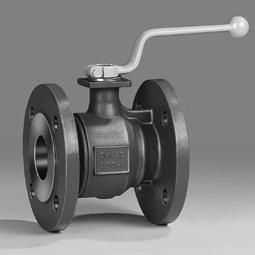Please do not block ads on our site. Clicks on ads help us exist, grow and become more useful for you!
Ball valve

Ball valve is a shut-off pipeline fitting. The valve's shut-off element has a spherical shape with a hole for the medium to pass through on its horizontal axis. Turning the sphere around its vertical axis opens the passage cross-section, and in the open position, the axis of the flow coincides with the axis of the hole in the sphere, while in the closed position, they are perpendicular to each other.
Operating media
Ball valves are used for shutting off the flow of water, steam, gas, air, oil, viscous and even abrasive media. All flanged valves presented in our catalog can be used for water, and the possibility of using them with other media should be clarified with the suppliers.
For water with a temperature up to 100°C and a pressure of up to 16 bar, with a nominal diameter up to DN50, threaded ball valves are used, and in other cases, welded or flanged ball valves are installed.
Application
Before the advent of polymer sealing rings, ball valves for water were rarely used due to the complexity of creating a tight seal between spherical metal surfaces. Modern ball valves are easy to install and can be installed in any position with any direction of water flow and practically under any environmental conditions. In addition, the simple design and low cost have contributed to the widespread use of ball valves in heating and water supply systems.
The ball valve can only operate in extreme open/closed positions; operation in intermediate positions will lead to abrasive wear of the ball and, as a result, to a violation of the tightness of the flow closure.
Advantages
- Long service life
- Absence of stagnation zones in the flow part
- High tightness of flow closure
- Small height dimensions
- Simple and reliable design
- Simple shape of the flow part
- Possible full bore design
- Low hydraulic resistance
- Can be installed in any operating position
- Does not require technical maintenance
- Simple operation (turning the stem by 90 °)
- Valves with a removable body are suitable for repair
- Possible quick closure (with manual control)
- Possible chamberless installation during underground pipeline laying
- Possible use with viscous or contaminated media, suspensions, and sludges
- Ball valves are bidirectional and allow any direction of the working medium
Disadvantages
- High cost
- High mass
- High torque is required for closure. Therefore, flanged valves DN125 and above with manual closure require equipping with a worm reducer, and with automatic control - expensive electric drives.
- Long handles are required for manual closure, which is not always convenient for chamber installation and installation in limited spaces.
- With manual closure, sharp opening of the valve can lead to hydraulic shocks, which is unacceptable for some systems.
What can be used instead
275
 Catalog of
Catalog of of ball valves
IVR
IVR
IVR
Genebre
Genebre
Danfoss
Ayvaz
Breeze
Breeze
Breeze
Breeze
Brandoni
Brandoni
Vexve
Vexve
Vexve
Vexve
Vexve
Vexve
Bray
FAF
FAF
Ukspar
Broen
Broen
Polix
Polix
Polix
LD
LD
Danfoss
Brandoni
IVR
Naval
Naval
Polix
Polix
FAF
Маршал
Маршал
Маршал
Genebre
Krom Schroder







